A Velocity-Aware Handover Trigger in Two-Tier Heterogeneous Networks
Abstract
:1. Introduction
2. Related Work
2.1. Velocity and Handover Performance
2.2. Handover Triggering
3. Overall Handover Procedures
3.1. Allan Variance and RSS
3.2. System Architecture
3.3. Handover Process Description
4. Experiments and Analysis
4.1. Experimental Setup
4.2. Simulation Analysis
5. Discussion and Future Directions
6. Conclusions
Author Contributions
Conflicts of Interest
References
- Lai, W.K.; Chiu, J.C. Improving handoff performance in wireless overlay networks by switching between two-layer ipv6 and one-layer ipv6 addressing. IEEE J. Sel. Areas Commun. 2005, 23, 2129–2137. [Google Scholar]
- Mahbas, Ali.; Zhu, H.; Wang, J. Mobility Management in Small Cell Networks. In Proceedings of the IEEE Globecom 2017, Singapore, 4–8 December 2017. [Google Scholar]
- Zhou, Y.; Ai, B. Handover schemes and algorithms of high-speed mobile environment: A survey. Comput. Commun. 2014, 47, 1–15. [Google Scholar] [CrossRef]
- Mansour, A.A.; Enneya, N.; Ouadou, M. A Seamless Handover Based MIH-Assisted PMIPv6 in Heterogeneous Network (LTE-WIFI). In Proceedings of the 2nd International Conference on Big Data, Cloud and Applications, Tetouan, Morocco, 29–30 March 2017. [Google Scholar]
- Baddour, K.E.; Beaulieu, N.C. Robust doppler spread estimation in nonisotropic fading channels. IEEE Trans. Wirel. Commun. 2005, 4, 2677–2682. [Google Scholar] [CrossRef]
- Arvind, M.; Güvenc, I. Handover count based velocity estimation and mobility state detection in dense HetNets. IEEE Trans. Wirel. Commun. 2016, 15, 4673–4688. [Google Scholar]
- Merwaday, A.; Güvenç, I.; Saad, W.; Mehbodniya, A.; Adachi, F. Sojourn time-based velocity estimation in small cell poisson networks. IEEE Commun. Lett. 2016, 20, 340–343. [Google Scholar] [CrossRef]
- Merwaday, A.; Ismail, G. Specific Velocity Estimation of Wireless Network Devices. U.S. Patent 9,584,976, 28 February 2017. [Google Scholar]
- Arshad, R.; ElSawy, H.; Sorour, S.; Al-Naffouri, T.Y.; Alouini, M.-S. Velocity-aware handover management in two-tier cellular networks. IEEE Trans. Wirel. Commun. 2017, 16, 1851–1867. [Google Scholar] [CrossRef]
- Zhang, R.; Wu, M.; Zhang, Y. Analysis of handover trigger scheme based on distance for LTE high-speed railway networks. TELKOMNIKA Telecommun. Comput. Electron. Control 2016, 14, 129–135. [Google Scholar] [CrossRef]
- Yang, Y.; Yu, P.; Li, W. Handover self-optimization mechanism based on velocity for cellular networks. In Proceedings of the 2012 7th International ICST Conference on Communications and Networking in China (CHINACOM), Kunming, China, 8–12 August 2012; pp. 606–610. [Google Scholar]
- Xu, P.; Fang, X.; He, R.; Xiang, Z. An efficient handoff algorithm based on received signal strength and wireless transmission loss in hierarchical cell networks. Telecommun. Syst. 2013, 52, 317–325. [Google Scholar] [CrossRef]
- Jain, A.; Tokekar, S. Optimization of vertical handoff in UMTS_WLAN heterogeneous networks. In Proceedings of the International Conference on Emerging Trends in Communication, Control, Signal Processing & Computing Applications, Bangalore, India, 10–11 October 2013; pp. 1–5. [Google Scholar]
- Sinclair, N.; Harle, D.; Glover, I.A.; Irvine, J.; Atkinson, R.C. An advanced som algorithm applied to handover management within lte. IEEE Trans. Veh. Technol. 2013, 62, 1883–1894. [Google Scholar] [CrossRef]
- Park, J.; Lim, Y. A handover prediction model and its application to link layer triggers for fast handover. Wirel. Pers. Commun. 2010, 52, 501–516. [Google Scholar] [CrossRef]
- Roy, A.; Shin, J.; Saxena, N. Multi-objective handover in lte macro/femto-cell networks. J. Commun. Netw. 2012, 14, 578–587. [Google Scholar] [CrossRef]
- Shi, J.; Wu, J.; Paul, A.; Jiao, L.; Gong, M. Change detection in synthetic aperture radar images based on fuzzy active contour models and genetic algorithms. Math. Probl. Eng. 2014. [Google Scholar] [CrossRef]
- Luo, C.; Higuera, P.C.; McClean, S.; Parr, G.; Grecos, C. Analysis of coloured noise in received signal strength using the allan variance. In Proceedings of the 2014 22nd European Signal Processing Conference (EUSIPCO), Lisbon, Portugal, 1–5 September 2014; pp. 994–998. [Google Scholar]
- IEEE Standard. Definitions of Physical Quantities for Fundamental Frequency and Time Metrology—Random Instabilities; IEEE Standard 1139-2008; IEEE: Piscataway Township, NJ, USA, 2009. [Google Scholar]
- Lesage, P.; Ayi, T. Characterization of frequency stability: Analysis of the modified allan variance and properties of its estimate. IEEE Trans. Instrum. Meas. 1984, 33, 332–336. [Google Scholar] [CrossRef]
- Kong, K.-S.; Lee, W.; Han, Y.-H.; Shin, M.-K.; You, H. Mobility management for all-ip mobile networks: Mobile ipv6 vs. proxy mobile ipv6. IEEE Wirel. Commun. 2008, 15, 36–45. [Google Scholar] [CrossRef]
- Andrews, J.G.; Buzzi, S.; Choi, W.; Hanly, S.V.; Lozano, A.; Soong, A.C.K.; Zhang, J.C. What will 5g be? IEEE J. Sel. Areas Commun. 2014, 32, 1065–1082. [Google Scholar] [CrossRef]
- 3GPP. Study on Architecture Enhancements for Cellular Internet of Things (Release 13); 3rd Generation Partnership Project TR 23.720; 3GPP: Phoenix, AZ, USA, 2016. [Google Scholar]
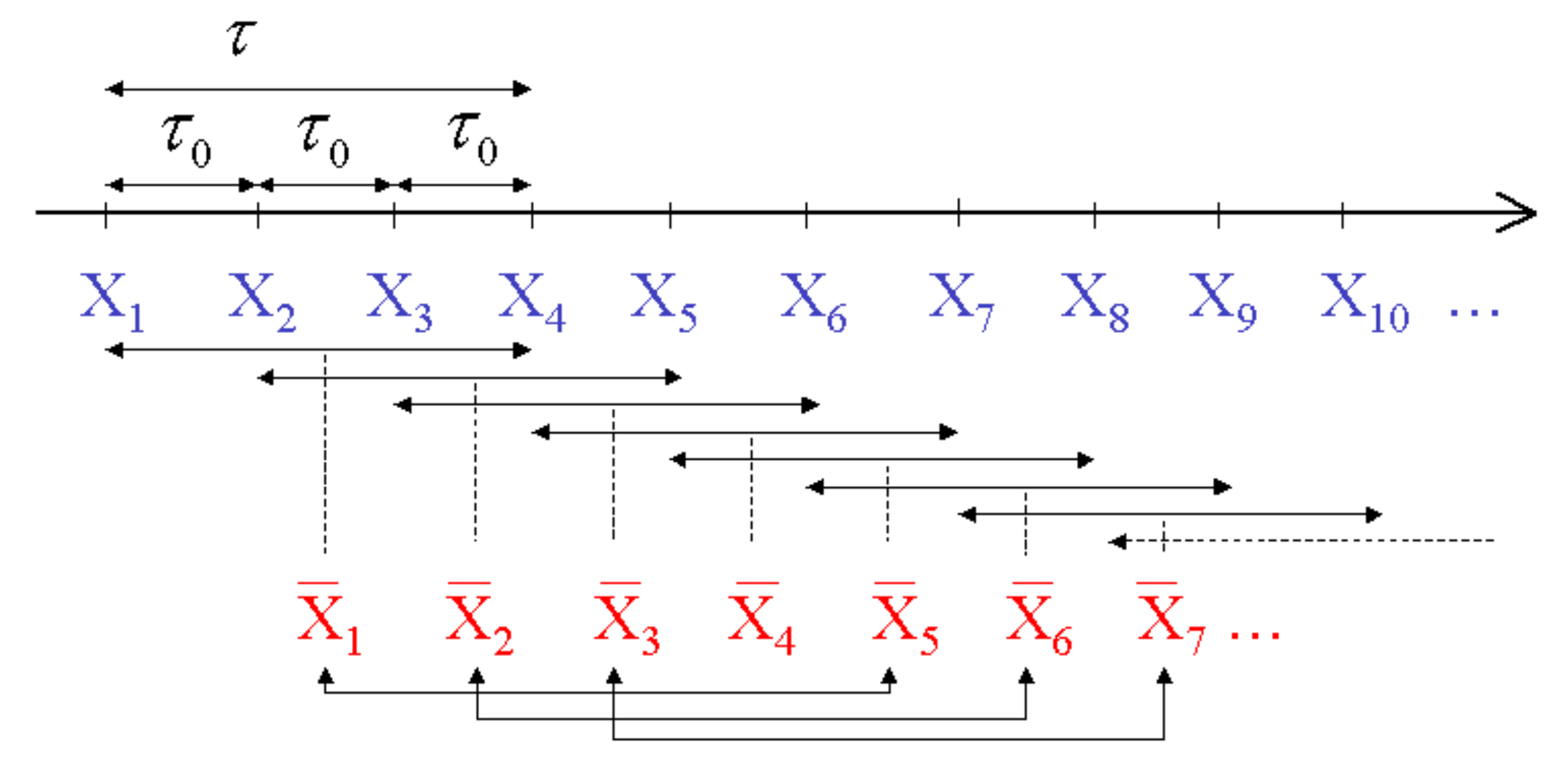
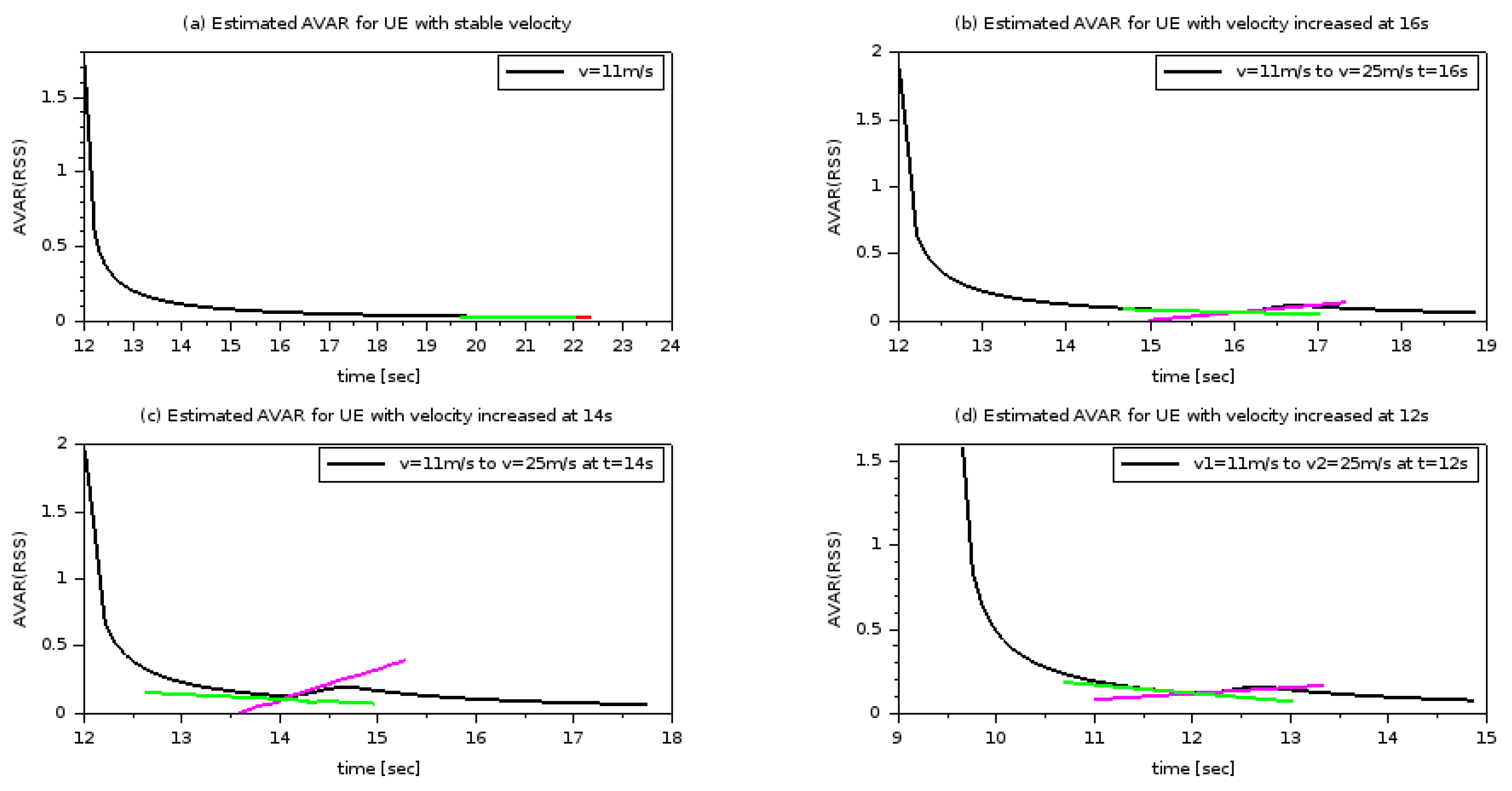
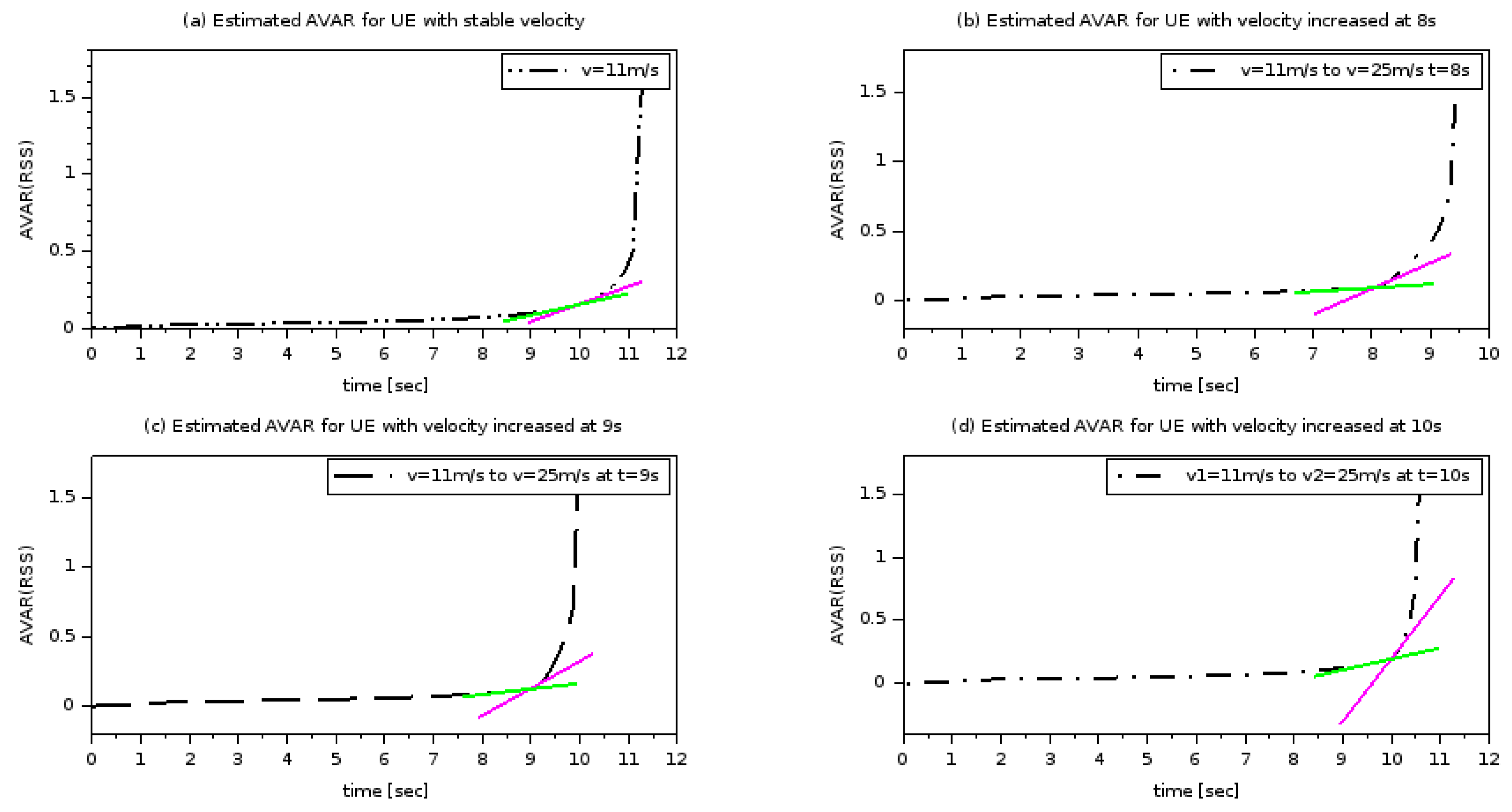
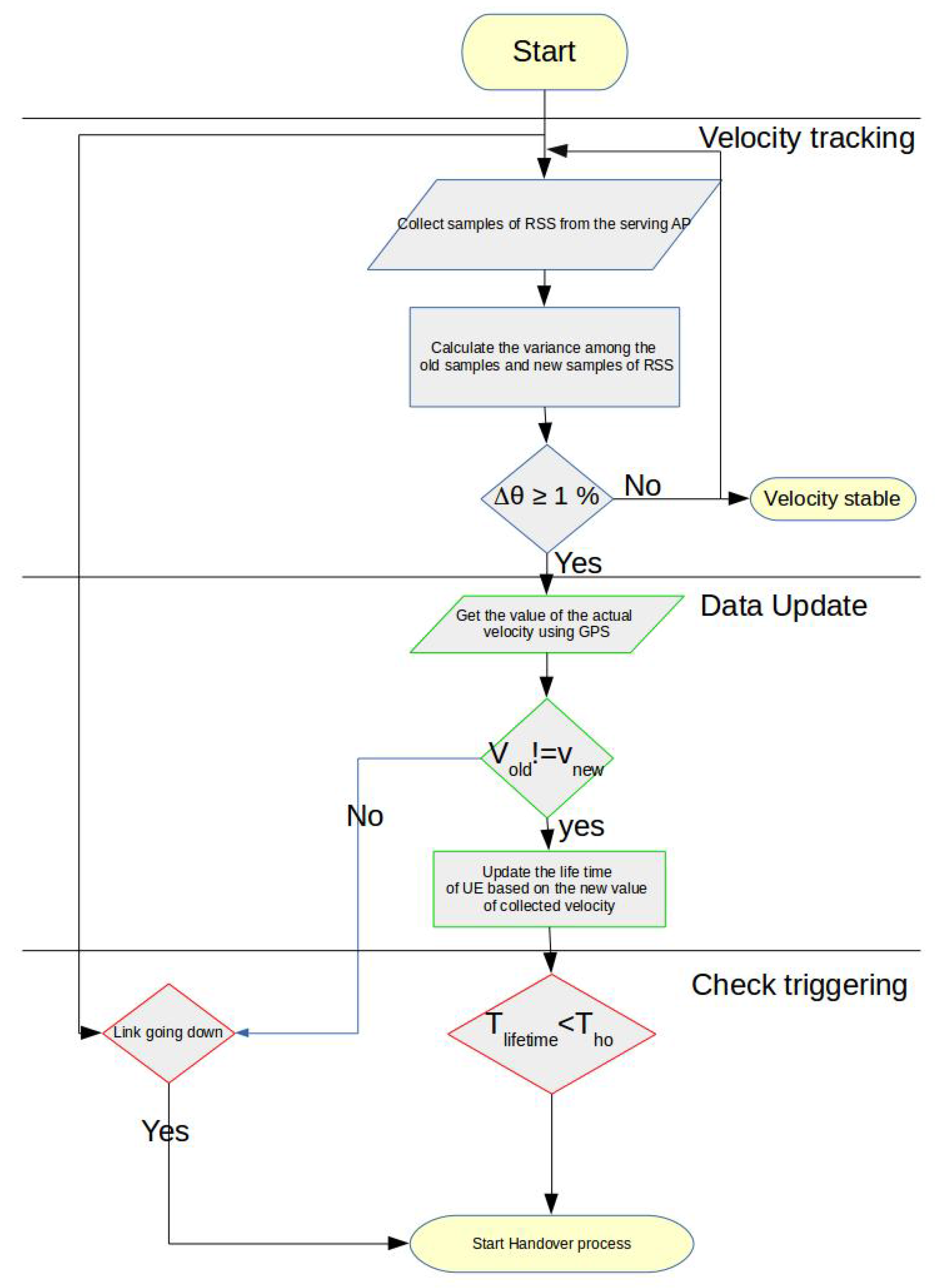
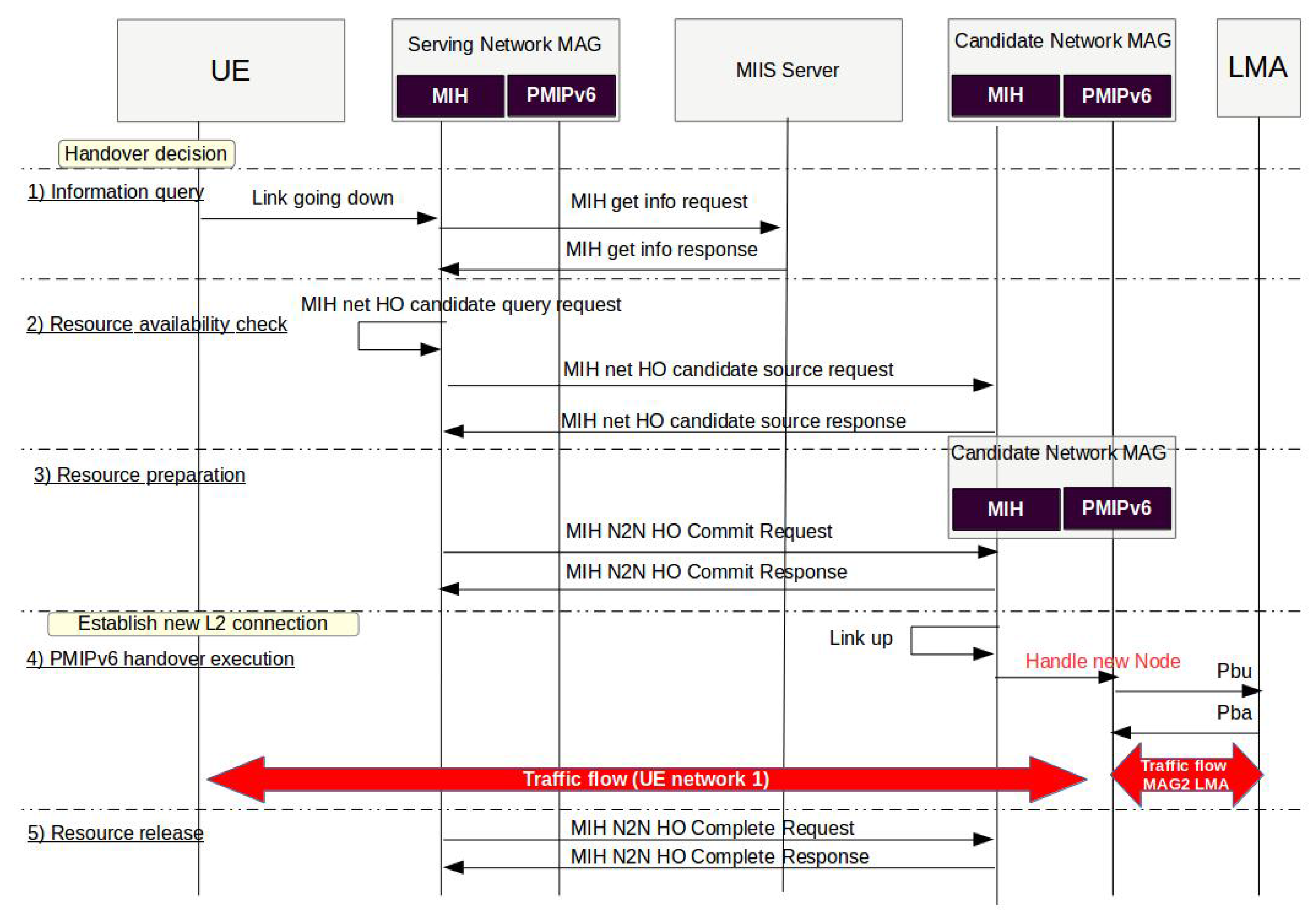
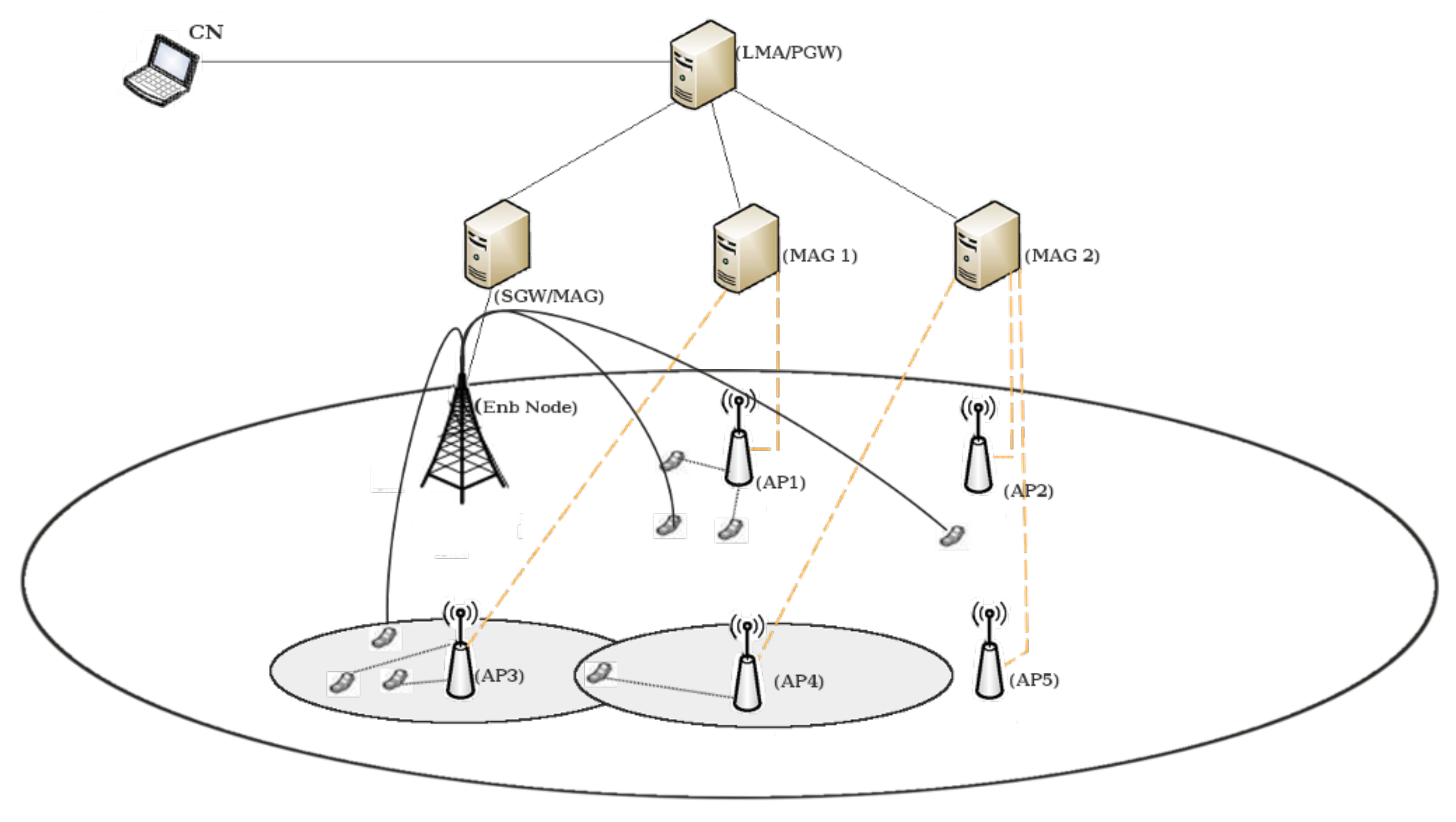

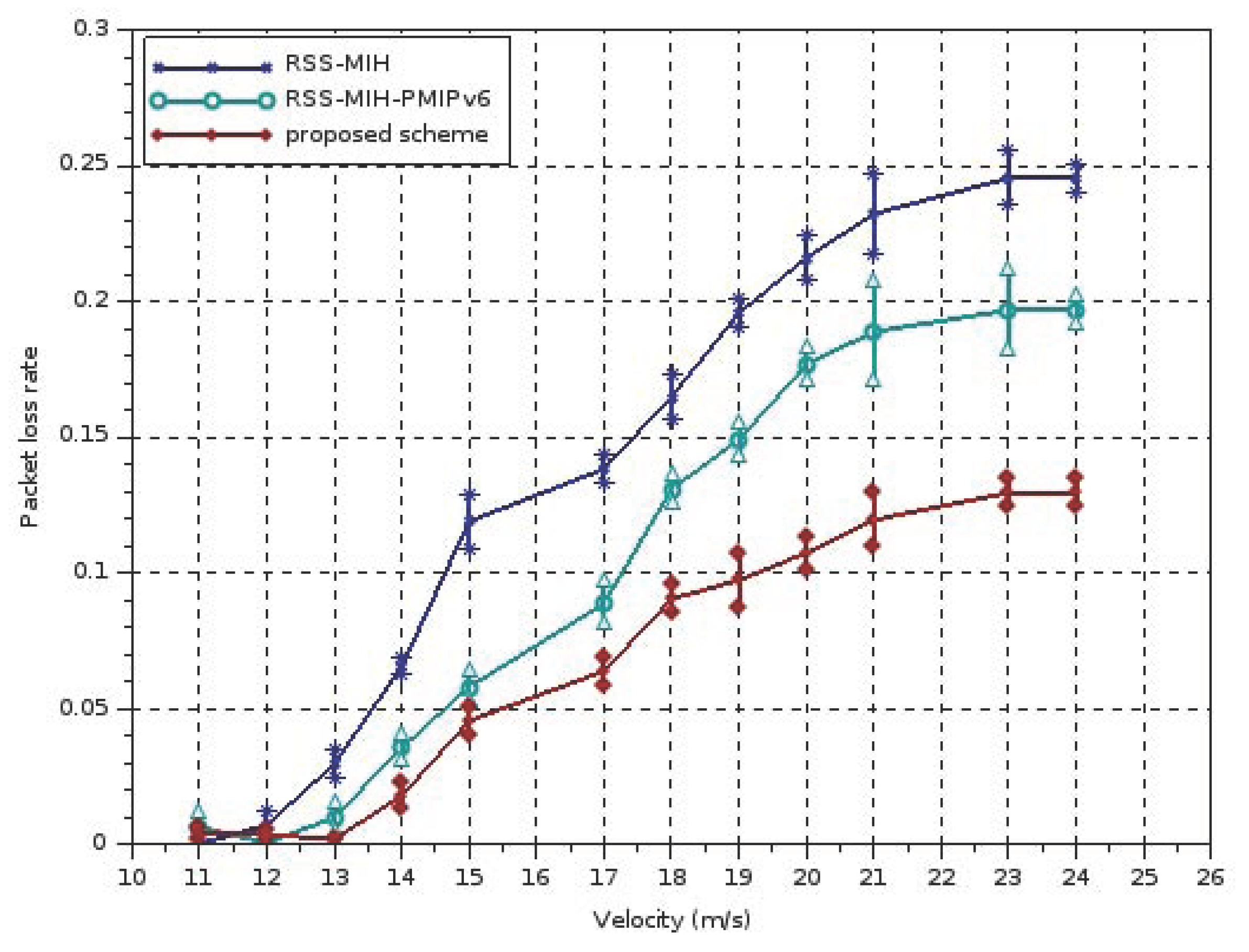
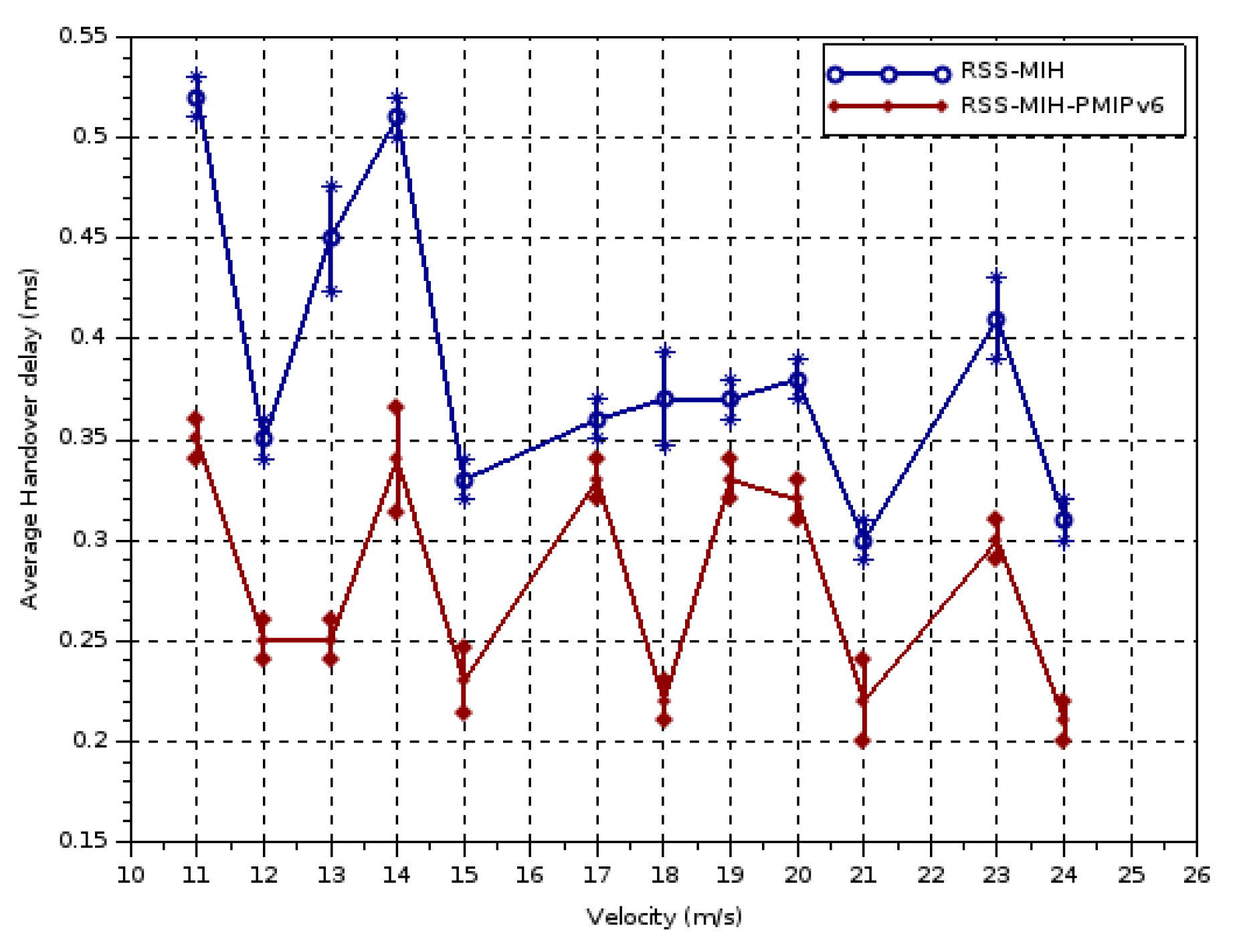
| Parameters | Values |
|---|---|
| Cell layout | 1 eNB, 6 APs |
| Propagation model | Range propagation loss model |
| LTE coverage | 500 km |
| WiFi coverage | 90 m |
| Mobility model | Random walk |
| Velocity | Urban (11 m/s, 25 m/s) |
| Packet size | 120 bytes |
| Number of UE units | 30 |
| Number of mobile UE units | 21 |
| Simulation time | 700 s |
| Main Characteristics | RSS-MIH | RSS-MIH-PMIPv6 | Proposed Scheme |
|---|---|---|---|
| Supports handover in different technologies | ✓ | ✓ | ✓ |
| Considers the variation velocity | x | x | ✓ |
| Updates the lifetime of the UE | x | x | ✓ |
| Gives the UE the possibility of finishing handover properly | x | x | ✓ |
| Manages environment data for decision-making | ✓ | ✓ | ✓ |
| Involves transparent mobility management for the UE | x | ✓ | ✓ |
| Is a proactive and intelligent triggering system | x | x | ✓ |
| Velocity (m/s) | 11 | 12 | 13 | 14 | 15 | 17 | 18 | 19 | 20 | 21 | 23 | 24 |
|---|---|---|---|---|---|---|---|---|---|---|---|---|
| LTE | 19% | 20% | 21% | 25% | 29% | 30% | 39% | 42% | 49% | 50% | 65% | 70% |
| WiFi | 81% | 80% | 79% | 75% | 71% | 70% | 61% | 58% | 51% | 50% | 35% | 30% |
© 2018 by the authors. Licensee MDPI, Basel, Switzerland. This article is an open access article distributed under the terms and conditions of the Creative Commons Attribution (CC BY) license (http://creativecommons.org/licenses/by/4.0/).
Share and Cite
Ait Mansour, A.; Enneya, N.; Ouadou, M. A Velocity-Aware Handover Trigger in Two-Tier Heterogeneous Networks. Future Internet 2018, 10, 9. https://doi.org/10.3390/fi10010009
Ait Mansour A, Enneya N, Ouadou M. A Velocity-Aware Handover Trigger in Two-Tier Heterogeneous Networks. Future Internet. 2018; 10(1):9. https://doi.org/10.3390/fi10010009
Chicago/Turabian StyleAit Mansour, Asmae, Nourddine Enneya, and Mohamed Ouadou. 2018. "A Velocity-Aware Handover Trigger in Two-Tier Heterogeneous Networks" Future Internet 10, no. 1: 9. https://doi.org/10.3390/fi10010009





